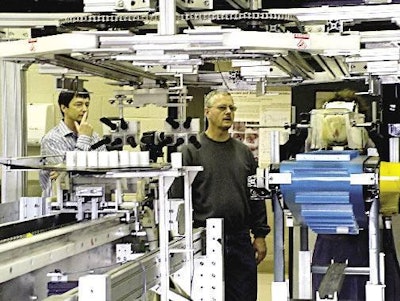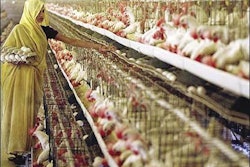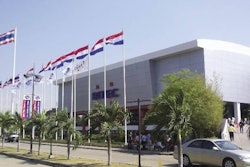
Hanging – the initial process in poultry plants where workers manually transfer live birds from a conveyor to a moving shackle line for processing – is considered a prime opportunity area for automated technology. In addition to its manual nature, the process is laborious and sometimes hazardous.
Workers perform a task that is highly repetitive and generates dust. In addition, the manner in which they handle the birds can impact product quality further down line. Georgia Tech researchers along with colleagues from the University of Georgia and USDA’s Russell Research Center are addressing this challenge with the development of an automated poultry transfer system.
Automatic Intelligent Transfer System
In tackling the problem of automating the live-hang process, Dr Kok-Meng Lee, a professor in the Georgia Tech School of Mechanical Engineering and project co-director, explains that unlike the handling of non-reactive objects, both mechanical forces and the bird’s natural reflexes contribute to the overall dynamics that a handling system faces. Recognising this, he and his Georgia Tech research team have been working with Dr Bruce Webster, a professor in the Department of Poultry Science at the University of Georgia, who specialises in animal behaviour. While Dr Lee and the Georgia Tech research team have used their engineering expertise to design the system components, Dr Webster and his colleagues have applied their knowledge of bird behaviour to address how the birds will respond to a mechanical transfer system. Their combined work has resulted in a handling system they call the Automatic Intelligent Transfer System.
The system is designed to transfer birds from the loading dock conveyor to the kill line and consists of four separate operations (singulating, separating, grasping and shackling), explains Gary McMurray, a research engineer at the Georgia Tech Research Institute and project co-director.
Singulating
The singulation system takes birds that are randomly positioned and oriented on the conveyor and outputs a single file of birds that are either facing forwards or backwards only. The spacing of the birds is irregular, but they are single file.
Separating
The separation system takes the irregularly spaced birds and spaces them at a pre-defined distance. This separation distance is critical to being able to shackle the birds.
Grasping
The grasping system then grasps the birds via a set of mechanical hands. At this time, the orientation of the birds is checked and the birds are rotated if necessary.
Shackling
The bird is then placed onto a moving perch where it is shackled through fixed automation.
The story so far
Mr McMurray says that the grasping and shackling systems have been extensively tested with a limited number of different sized birds. He believes these initial tests are encouraging and indicate that the team is on the right path. Further tests are planned for the singulation and separation systems at the University. During the tests, the two systems will be evaluated as a complete system. The team will manually place birds on an in-feed conveyor to simulate the loading of the birds from a typical conveyor at the loading dock. The birds will then run through the singulation fingers to the separation fingers, and finally be placed onto a perch. Because singulation and separation are performed while the birds are relatively unconstrained, they are probably among the most difficult tasks to automate with any degree of control. Mr McMurray says that these tests are critical to the future success of the system.
The next step: testing the complete system
If the testing of the combined singulation/separation system proves successful, researchers will then focus their efforts on adding the grasping and eventually the shackling system to form a completely integrated system. This final design will then undergo extensive testing at a poultry facility followed by commercialisation.
“Automation of poultry handling has the potential to improve product quality and economic return by potentially reducing rates of bruising and stress-related meat downgrading. Automation can also reduce labour costs and improve workplace safety,” says Dr Lee.
Possible bird welfare benefits
In addition, the system under development has the potential to improve humane handling practices. According to Dr Lee, birds tend to be less reactive to mechanical soft fingers than to human handlers. It is intended that, once cradled mechanically, the bird be rendered instantaneously insensible to pain by electrical stunning so that it may be killed humanely.
For this, the research team has partnered with Dr Jeff Burr, an animal specialist with USDA’s Russell Research Center, who is studying stunning and killing options.
Dr Lee notes that in order to reduce the number of live birds that had to be evaluated experimentally, computer simulations based on force and motion prediction models developed in the team’s earlier research efforts have been employed to aid the control system design of the automated transfer system.
“The collaborative efforts are helping to define an improved and humane live bird transfer system characterised by a minimum variability in bird response and struggle.
The potential benefits and payback of the automation include a reduction in labour costs, the elimination of manual repetitive tasks, and the potential to reduce product quality impacts from the handling process,” explained Dr Lee.
“This development is also helping to create a fundamental science and technology base that will support future innovations in poultry handling. Previously, product size/shape variety and the birds’ natural reflexes have made handling automation a challenging problem too complex to address,” concluded Dr Lee.
Georgia Tech Research Institute
This article is based on one published in PoultryTech, which is published by the Agricultural Technology Research Program (ATRP), Food Processing Technology Division of the Georgia Tech Research Institute (GTRI). ATRP is conducted in co-operation with the Georgia Poultry Federation with funding from the Georgia Legislature, USA.

















